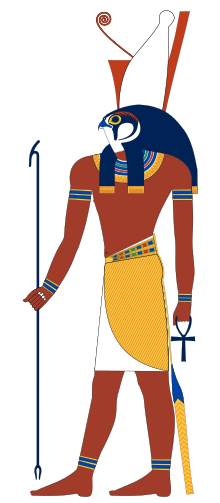Harpur calls the Gospels myth, but insists this is not the same as calling them a lie. They are spiritual truths, he explains, but not literally true. P. 39: “There was one primal, central myth—originating undoubtedly in Egypt—and all the rest flowed from that.” P. 30: Harpur quotes Kuhn, then explicitly agrees, saying that “no one can make the search and discover these numberless resemblances without forming the conviction that the Bible writings are rescripts, often … corrupted, of antecedent wisdom literature.”
This is the fallacy of the false alternative. They can be both. Not only is this not the only possible explanation for these claimed similarities; it is one explanation that does not work.
What Harpur says about myth is half true. The common use of the term to mean “falsehood” is wrong. “Myth” literally means “story,” but its deeper meaning is those stories that seem to especially resonate with us.
Like Zeus or Herakles, characters like Scrooge or Falstaff or Babbitt are mythic. They seem to resonate in our consciousness, to have a life of their own beyond the page or the stage.
 |
| A modern icon by Andy Warhol, who was an Eastern Catholic. Is she ahistorical? |
But Harpur shows he does not really understand the term, because without saying so, he assumes that the fact that Jesus’s story is mythic means that it is not historical. This is just the popular misconception that myth means falsehood persisting. In fact, the English word “history” means exactly what the Greek word “mythos” means: story (compare the French “histoire”). Characters like Hitler, Mother Teresa, or Marilyn Monroe, or stories like the Titanic or the Kennedy assassination, are also perfectly mythic in the proper sense. They resonate and are memorable. Yet they are also historical. In fact, it is primarily the myths of history that we remember.
Harpur claims that the Gospel accounts of Jesus’s life were originally intended to be read symbolically, yet later, were reinterpreted as literal. This requires the hypothesis that the earlier, correct reading was suppressed by a vast conspiracy. Harpur, p. 50: “a conspiracy had operated over a span of centuries.”
This idea of a conspiracy operating with perfect efficiency over centuries is so improbable it sounds like paranoid thinking. It sounds delusional.
In any case, it cannot be. The gospels and the epistles themselves make it clear they are claiming the events to be historical.
 |
| What an ahistorical character looks like. |
One should look for rhetorical clues in the text itself to understand the author’s intent. If you are writing ironically, you must include sufficient information that the alert reader can see the irony; if you are writing allegorically, you must do the same, or the allegory fails. If you do not, you are not expressing yourself well. So, if you mean to tell a story that is purely allegorical or fictional, you begin it “once upon a time,” or words to that effect: “there once was a king who …”; “long ago in a galaxy far away.” “In Never-Never Land…” “In Utopia .” “It was a bright cold day in April, and the clocks were striking thirteen.” “Somewhere in la Mancha, in a place whose name I do not care to remember, a gentleman lived not long ago…” (Points for recognizing the stories that so begin).
Time and place are made deliberately vague to make the point, “this is not to be read literally, as happening at one particular time and place, but has a symbolic meaning.”
Note, by contrast, how the gospel for a few Sundays ago began:
In the fifteenth year of the reign of Tiberius Caesar,
when Pontius Pilate was governor of Judea,
and Herod was tetrarch of Galilee,
and his brother Philip tetrarch of the region
of Ituraea and Trachonitis,
and Lysanias was tetrarch of Abilene,
during the high priesthood of Annas and Caiaphas,
the word of God came to John the son of Zechariah in the desert.
John went throughout the whole region of the Jordan,
proclaiming a baptism of repentance for the forgiveness of sins, …
Nothing vague there; the evangelist is going to great lengths to nail it all down so that it can be traced. Nothing could be plainer (or more important in the chronicler’s mind) than that this is a historical event, not something allegorical or to be read only metaphorically.
And, as I noted previously in my commentary on The Pagan Christ, St. Paul insists on the historicity of Jesus’s resurrection as the single most important thing in the Christian message, the sine qua non.
1 Corinthians 15:
14 And if Christ has not been raised, our preaching is useless and so is your faith. 15 More than that, we are then found to be false witnesses about God, for we have testified about God that he raised Christ from the dead. But he did not raise him if in fact the dead are not raised. 16 For if the dead are not raised, then Christ has not been raised either. 17 And if Christ has not been raised, your faith is futile; you are still in your sins. 18 Then those also who have fallen asleep in Christ are lost. 19 If only for this life we have hope in Christ, we are of all people most to be pitied.
Just as Harpur says, there is nothing Jesus says that some other figure had not said in some way before; differences are in emphasis, no more. This is necessarily so, because truth does not change with time, and God would not have concealed truth from mankind at any age. The message of Christianity is not the words of Jesus; the message is Jesus. “I am the Way, the Truth, and the Light.”
And this means Christ crucified, crucified in the flesh. This is essential to Christian theology. God himself died to expiate our sins. If Christ did not die, in the flesh, as Paul says, our sins are not forgiven. We have no hope of heaven.
 |
| Origen, Church Father and "Father of the Homily" |
Harpur’s great champion of the “esoteric” reading of scripture is Origen. Harpur writes, “Once the early Church turned to literalism and an exoteric, bottom-line rendering of the faith, Origen was condemned as a heretic and his books were banned.” But Origen’s style of reading the Bible did not see it as purely allegorical, and Origen’s style of reading the Bible has never been condemned by the Church. The Catholic Encyclopedia mostly praises rather than condemns Origen’s Biblical exegesis, calling him the “father of the homily,” and saying his principles for reading the Bible are “unimpeachable” and “proof against criticism.”
Origen certainly believed in the historicity of Jesus of Nazareth, and of his crucifixion and resurrection.
Origen’s views were later condemned by many not because of how he interpreted the Bible, but because of his other beliefs: in the preexistence of souls, and in universal salvation.
 |
| Quetzalcoatl |
Harpur himself claims that Cortez found Aztec religion to be strikingly similar to Christianity (p. 29). The real similarities, indeed, seem just about as strong as those to Egyptian religion. If Horus is a type of Christ, then so is Quetzalcoatl, or the Hawaiian god Kaili. There is no plausible way some ancient wisdom literature could have been known to Europeans, and also not only to people off in the middle of the Pacific Ocean, and also in the Americas, isolated from the rest of the world for an estimated 12,000 years---since long before the invention of writing. On top of this, as Jung has demonstrated, the same myth motifs appear spontaneously in people’s dreams and fantasies, when they could not possibly have read the ancient or foreign texts in which these myths appear.
The far more plausible explanation is that these myths are imbedded somehow in our consciousness as humans. And the simplest explanation of this is that God put them there. If God did this, he is also fully capable of making the same thing happen in the physical world, in history. Why not? Moreover, if he wants to put it in our consciousness, it is obviously important. If it is important, then he obviously would also want to do it historically, in the physical world.














